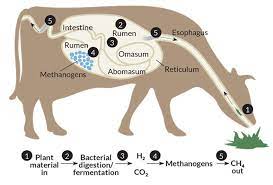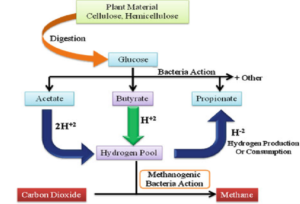Nutritional management and mitigation strategies to reduce Methane emissions from Bovines
S.Navaneetha Krishnan, Anchal Keshri, R.K .Jain, A.K .Patil, Naresh Kurechiya, Praveen Dodwa and Vaihsali Jain
Introduction
In 20th Livestock Census, 35.94%-Cattle, 27.80%-Goat, 20.45%-Buffaloes, 13.87%-Sheep, 1.69%-Pigs are present and The total Livestock population is 535.78 million in the country showing an increase of 4.6% over Livestock Census- 2012. Livestock is a substantial contributor to global GHGs, with emissions estimated at 8.1 gigatons of CO2-eq per annum or 14.5% of total anthropogenic emissions.The GLEAM results indicate that emissions from livestock supply chains consist of 50% methane (CH4), 24% nitrous oxide (N2O), and 26% carbon dioxide (CO2). In terms of species, cattle are the major contributor, with about 60% of total livestock emissions.Five states, namely Andhra Pradesh (undivided), Madhya Pradesh, Maharashtra, Rajasthan and Uttar Pradesh, together contribute to almost half of the total enteric methane emission. While AP, MP, Maharashtra and Rajasthan respectively, account for 0.73, 0.79, 0.70 and 0.81 Tg of annual enteric methane emission, UP is the largest emitter contributing 1.52 Tg.
Why we should worry about methane?
Methane, the second most abundant greenhouse gas after carbon dioxide (CO2), which is 28 times powerful than CO2 at warming the atmosphere, and is responsible for almost a quarter of global warming. India is currently the world’s fourth largest methane emitter after China, the United States and Russia, according to the climate data website Climate Watch, managed by the World Resources Institute. In India, which has the world’s largest cattle population and is the second largest rice producer, the agriculture sector emits five times as much methane as the energy sector. Agriculture accounts for 61% of total methane emissions, while India’s energy sector accounts for 16.4% and waste 19.8%, per the global methane tracker 2022
Mechanism of enteric CH4 production during digestion in the rumen
PRECISION FEED MANAGEMENT:
Precision feed management (PFM) is one tool that the dairy industry can use to address concerns about environmental impact. The simple definition of PFM is to provide adequate, but not excess nutrients, to support animal health and productivity. The continual process of providing adequate, but not excess, nutrients to the animal and deriving a majority of the nutrients from the homegrown feeds through the integration of feeding and crop management for the purpose of maintaining farm environmental and economic sustainability. Precision feed management can improve the efficiency of producing milk.
ADVANTAGE:
- Protects reproductive health and milk production while reducing the nutrient loss in manure.
- Only 25-30% of the nitrogen in feed goes into milk, with the rest excreted in faeces and urine.
- Potential for reducing nitrogen, phosphorus, methane excretion using various feeding systems and technology.
- Dairy diets often have 120-160% of the phosphorus and the excess is excreted in manure.
- Reduce cost of feed.
IMPLICATIONS OF FEED ADDITIVES AND ITS ROLE:
RUMEN INHIBITORS :
Feed additives classified as CH4 inhibitors directly act on the methanogenesis pathway in a way that can disrupt the process and reduce CH4 production (g/day) Methanogens prevent H2 accumulation in the rumen, which otherwise may lead to adverse effects on fibre degradability and animal performance .
1] 3-NITROXYPROPANOL (3NOP, marketed as Bovaer in the European Union)
More than 15 studies have been conducted using 3NOP, showing a marked reduction of enteric CH4 emissions with a range of effectiveness. 3NOP added to ruminant diets in small quantities has been shown to persistently reduce enteric CH4 emissions by inhibiting an important step in the methanogenesis metabolic pathway, without apparent negative side effects
2] HALOGENS– Plant species that accumulate halogenic compounds in their tissues have been investigated for their potential to reduce enteric CH4 emissions.Dose- At supplementation level of 1.50–1.59g/kg DM (2.6g/100kg liveweight; mean liveweight=288 kg) of chloroform-cyclodextrin, steers have demonstrated a 30-35% reduction in enteric CH4 production, with no detectable differences in rumen fermentability.
3] FREEZE DRIED ASPARAGOPSIS MEAL
Seaweeds, popularly known as macro algae, have the potential to reduce enteric methane emissions. Recently, researchers have established that the red algae Asparagopsistaxiformis, to a great extent, inhibits methanogenesis. It has been hypothesized that Asparagopsis inclusion rates should not exceed 1% DM due to reductions in dry matter intake at higher inclusion levels, with many studies using 0.2–0.5% Asparagopsis DM in diet DM.
4] NITRATE
Adding nitrate to ruminant diets can be an effective CH4 mitigation strategy because nitrate competes with methanogens for H2 in the rumen.Because a potentially toxic intermediate, nitrite (NO2 ̄), is produced and can accumulate in the rumen and enter the blood, the dose is typically limited to 2% nitrate in the diet DM.
RUMEN MODIFIERS:
The rumen environment can be modified with feed additives to limit the growth of methanogens and to suppress CH4 production, without targeting the specific methanogenesis pathway.
1] DIETARY LIPIDS
Dietary lipids modify the rumen environment in several ways, including
- Toxic characteristics on methanogens and protozoa.
- Hydrogenation of unsaturated fatty acids (alternative H2 sink).
Shifts to propionic production, leading to reduction of enteric CH4 production
2] MEDIUM CHAIN FATTY ACIDS
These include lauric, myristic, capric and caprylic acids In vitro studies have reported coconut oil, which contains 75% of MCFA, to reduce CH4 production by 43-85%. Application of coconut oil in in vivo trials also showed similar patterns in CH4 reduction
3] POLYUNSATURATED FATTY ACIDS
Polyunsaturated fatty acids have also been shown to reduce CH4 production. For example,found that enteric CH4 production reduced by 29.5% with supplementation of 60g/kg DM of camelina oil, but other parameters such as milk yield and milk components were compromised
4] IONOPHORES
Ionophores, such as monensin, alter rumen microbial populations to improve digestive efficiency by depriving methanogens of substrates that are typically provided by Gram-positive bacterial and ciliate protozoal populations. This fermentation shift favours the production of propionate over acetate, which reduces the amount of H2 available for methanogens.
5] TREE LEAVES
Tree leaves are rich in plant secondary metabolites such as tannins, saponins and essential oils. Studies carried out by NIANP (Current Science Volume 125) have established that inclusion of tropical tree leaves such as jack fruit, neem and banyan at 5% in the diet effectively decreases enteric methane emissions without affecting feed fermentation in the rumen.
HARIT DHARA:
After systematic in vitro and animal studies, scientists at NIANP have developed an anti-methanogenic feed supplement named ‘Harit Dhara’. This product has been evaluated for reduced daily enteric methane emissions and impact on the productivity of the farmers’ dairies. Keeping in view the economic status of our farmers, ‘Harit Dhara’ was formulated using affordable and abundant phyto-materials so that it can be easily fed. When fed to ruminants (cattle, buffaloes, sheep and goats), it is found to be quite effective in reducing the daily enteric methane emission by about 20%.
ESSENTIAL OILS AND ITS BLEND:
Essential oils (EOs) are volatile aromatic compounds produced by plants (herbs and spices) as complex mixtures of secondary metabolites. They are not fatty acids but are hydrophobic (water repelling) compounds, usually present in mixtures with 20-60 components including alcohols, aldehydes, hydrocarbons, ketones, esters and ethers.EO blends have demonstrated a greater feed efficiency and a higher production of energy-corrected milk in dairy cattle through modification of rumen fermentation
- GARLIC
- LEMON GRASS
- CINNAMON OIL
- AGOLIN
- MOOTRAL [garlicand flavonoid-containing citrus extract]
CONCLUSION:
The urgency of intercepting enteric methane emissions from livestock needs to be emphasized. Adopting farmer 4-friendly and affordable technologies would have multiple benefits in attaining a desirable reduction of 15–20% in daily enteric methane emissions. This would not only contribute to our commitment to attainable zero-carbon emissions by 2070 but also would improve the economic progress of dairy farmers through production and productivity enhancement. Adopting a single approach across the country as a mitigation strategy may not work out, given various known and unknown factors. Therefore, devising multiple, region and season-specific approaches and different prongs could prove to be viable options in addressing this critical issue. Implementing livestock management strategies to reduce methane emissions provides primary producers with opportunities to act on climate change, increase livestock productivity and improve profits.




